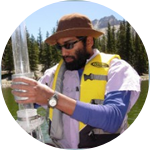Project Results
I am very excited to share this manuscript talking about Holocene paleohydroclimate and paleoenvironmental change and the 5.2 ka abrupt climate change event occurred at glacial massif of central Costa Rica that is officially published! The greatest appreciation goes to all the backers for this crowdfunding project. We wouldn't be able to complete this research without your support!!!
PS: The funding collected from experiment.com was finally decided to apply on conducting more radiocarbon dates to refine the chronology of DKB core, and undertaking high-resolution charcoal and geochemistry analysis, instead of stable oxygen isotope analysis on subfossil chironomids as we requested, due to some budget adjustment. But we have successfully received a grant recently from International Association of Sedimentologists (IAS) that enables a preliminary test of stable oxygen isotope analysis on subfossil chironomid remains (δ18Ohc) in the DKB core.
Holocene hydroclimate and environmental change inferred from a highresolution multi-proxy record from Lago Ditkebi, Chirripó National Park, Costa Rica
Jiaying Wu, David F. Porinchu, Nicole L. Campbell, Taylor M. Mordecai, Evan C. Alden
About This Project
Páramo, high-elevation tundra ecosystem, is considered as an important biodiversity hotspot. Páramo is a fragile system due to its slow recovery rate after disturbance such as wildfire. Nowadays, páramo in central Costa Rica is under threat from more potential fires due to climate warming. Long-term hydroclimate reconstructions for this region will enable us to better understand the past climate change, its impact on high elevation vegetation and fire activities, and to better conserve páramo.
Ask the Scientists
Join The DiscussionWhat is the context of this research?
Páramo is a high-altitude ecosystem only found in Neotropics (Fig. 1), with unique and extremely diverse with up to 60% of its ~4000 species of vascular plants endemic. Chirripó páramo within Chirripó National Park of central Costa Rica is the most northwestern extend of páramo distribution in the Neotropics (Fig. 1); it has been considered as an important biodiversity and evolutionary hotspots in Neotropical biological corridors. However, nowadays, Chirripó páramo ecosystem is under threat from potentially intensified and increasing fires due to global warming and significantly reduced rainfall during dry seasons. Efficient fire management for Chirripó páramo requires us to improve our understanding of linkages between long term hydroclimate change and fire activities in this region.
What is the significance of this project?
Ecosystems in mountainous regions, such as páramo located within alpine tundra areas of central Costa Rica, are particularly vulnerable to climate change due, in part, to the amplification of warming at high elevations that is expected to occur in response to anthropogenic forcing of the climate system. Understanding the magnitude and range of past hydroclimate variability in central highlands of Costa Rica, and its impact on high elevation ecosystems (e.g. vegetation type) and landscape change (e.g. fire history), provides a basis for better predicting fire activities and fire management in Costa Rica, and also for better conserving the biodiversity and endemicity of Chirripó páramo ecosystem.
What are the goals of the project?
The proposed research aims at developing new proxy-based reconstructions of hydroclimate change for Costa Rica spanning the past 8000 years by analyzing the stable oxygen isotope signals extracted from subfossil chironomid head capsule remains preserved in lake sediments in Lago Ditkebi within Chirripó páramo. The records developed in our study will 1) provide the means to quantify hydroclimate variability during Holocene of central Costa Rica, 2) together with existing paleostudies will help relate changes in climate to observed changes in vegetation composition and to fire activities, 3) address questions related to ecosystem response to climate forcing over the long-term, and 4) improve fire prediction and management for neotropical páramo ecosystem.
Budget
We have conducted fieldwork in July 2014, and obtained a 5.75m long sediment cores from Lago Ditkebi, a glacial lake within Chirripó National Park, Costa Rican, and two other short cores in the nearby glacial lakes. The funds requested from experiment.com will be used to pay the cost of stable oxygen isotope analysis on subfossil chironomid, in order to extract d18O signal from subfossil chironomid head capsules preserved in lake sediments of Lago Ditkebi to establish an 8000-year high resolution hydroclimate reconstruction. The hydroclimate records produced in this project will be compared to the existing pollen-based vegetation reconstruction and charcoal-based fire history within Chirripó páramo spanning the past 8000 years, to assess the linkage between Holocene hydroclimate and fire intensity and frequency. The oxygen isotope analysis will be conducted at the Center of Applied Isotope Studies (CAIS) at the University of Georgia at the rate of $30/sample for 140 chironomid samples.
Endorsed by
Meet the Team
Affiliates
Jiaying Wu
Hello, everyone, I am a Ph.D student at geography department in University of Georgia (Athens, Georgia). Born in a family with parents studying climate and botany, I have been always fascinated with the interactions between these two categories. Tropical climate was thought to be stable, and tropical vegetation was also considered to be little changed during the last 10,000 years. However, in recent decades, numerous proxy-based paleo-environmental reconstructions, developed for central to southern Costa Rica, have led to the rejection of the assumption of tropical climate and vegetation stability, and also led to the discussion of the influence of anthropogenic impacts on the landscape during prehistoric times. As a paleoclimatologist, understanding how long-term climate varies and disentangling how climate influences landscape change in the geologic past are my top research interests. If we can better characterize how has hydroclimate fluctuated during the Holocene, and how climate change influenced vegetation and landscape change we will be better positioned to predict how projected climate change will influence the Páramo. I am very excited about the potential of my project and I am looking forward to combining my paleohydroclimate reconstructions with what is known of past fire history to interpret landscape change in Costa Rica during the Holocene. ResearchGate link
Dr. David Porinchu
I am Jiaying's research advisor. My specialty is biogeography, paleolimnology, paleoclimatology, water resources, and climate change. My team and I have reconstructed paleoclimate change spanning for late Quaternary for multiple mid-to high latitud sites, including Russia, Canada, Sierra Nevada in California, Rocky mountain regions in Colorado, by using chironomid as a biomark proxy. I am very excited about Jiaying's Costa Rica project, and expecting to see how did thermal conditions vary in Costa Rica (within low-latitude region) during Holocene and how fire history and landscape change can be linked to the Holocene hydroclimate change.
Some stories from the field:
http://geography.uga.edu/article/a-rare-glimpse-in...
Press and Media
Publications:
Wu, J., Porinchu, D.F. and Horn, S.P., (under review). A chironomid-based reconstruction of late Holocene climate and environmental change for southern Pacific Costa Rica. The Holocene.
Wu, J., Porinchu, D.F., Horn, S.P., and Haberyan, K.A., 2015. The modern distribution of chironomid sub-fossils (Insecta: Diptera) in Costa Rica and the development of a regional chironomid-based temperature inference model. Hydrobiologia 742, 107-127.
Awards and Honors:2016, Graduate School Travel Grant ($600), UGA
2015, Doctoral paper presentation competition first place ($100) at Association of American Geographers (AAG)
2015, Graduate School Travel Grant ($400), UGA
2015, Geological Society of America graduate student research grant ($1800)
2012, James O. Wheeler Travel Grant ($500), Geography Dept. UGA
Additional Information

Typical Páramo vegetation type observed in Chirripó National Park located at the glacial massif of central Costa Rica (July 2014, Pic by Jiaying Wu)

It took us 9.5 + 2 hours to hike to our target lake, Lago Ditkebi, located within highland Páramo region in Chirripó National Park isolated from human activities. It is only a 14 km trail from San Gerado to the refugee near Cerro Chirripó, but the elevation changes from ~1400 m to 3400 m (above sea level). The last hour of hiking, we hiked in shower.
The target lake, Lago Ditkebi. In the picture, Dave and Licho were assembling a platform that will be fixed on two inflated air boats for coring station.
We were setting up the coring platform near the center of the Lago Ditkebi.

Extracting a long core was never easy, particularly under bad weathers. We spent days at the site, but everyday only had 2-3 hours sunny time can work on coring sediments, the rest of the day we had to survive dense fog, heavy rain and strong wind. Luckily, we got a 5.75m long core back.
We were hiking to another two glacial lakes, Morenas and Chirripó lakes. Moraine landscape was commonly observed in these regions.

Approaching to study sites (left: Morrenas Lakes, right: Chirripó Lake).

We have successfully gotten back from Costa Rica in one piece and taken back our lake sediment cores waiting for being analysed!
I am working on identifying biomarkers (Chironomids) in lake sediments.
Project Backers
- 71Backers
- 101%Funded
- $4,260Total Donations
- $60.00Average Donation




